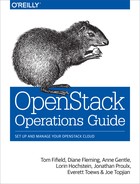Chapter 17. Advanced Configuration
OpenStack is intended to work well across a variety of installation flavors, from very small private clouds to large public clouds. In order to achieve this the developers add configuration options to their code which allow the behaviour of the various components to be tweaked depending on your needs. Unfortunately it is not possible to cover all possible deployments with the default configuration values.
At the time of writing, OpenStack has over 1,500 configuration options. You can see them documented at the OpenStack configuration reference guide. This chapter cannot hope to document all of these, but however we do try to introduce the important concepts so that you know where to go digging for more information.
Differences between various drivers
Many OpenStack projects implement a driver layer, and each of these drivers will implement their own configuration options. For example in OpenStack Compute (Nova), there are various hypervisor drivers implemented -- libvirt, xenserver, hyper-v and vmware for example. Not all of these hypervisor drivers have the same features, and each has different tuning requirements.
The currently implemented hypervisors are listed on the OpenStack documentation website. You can see a matrix of the various features in OpenStack Compute (Nova) hypervisor drivers on the OpenStack wiki at the Hypervisor support matrix page.
The point we are trying to make here is that just because an option exists doesn’t mean that option is relevant to your driver choices. Normally the documentation notes which drivers the configuration applies to.
Periodic tasks
Another common concept across various OpenStack projects is that of periodic tasks. Periodic tasks are much like cron jobs on traditional Unix systems, but they are run inside of an OpenStack process. For example, when OpenStack Compute (Nova) needs to work out what images it can remove from its local cache, it runs a periodic task to do this.
Periodic tasks are important to understand because of limitations in the threading model that OpenStack uses. OpenStack uses cooperative threading in python, which means that if something long and complicated is running, it will block other tasks inside that process from running unless it voluntarily yields execution to another cooperative thread.
A tangible example of this is the nova-compute process. In order to manage the image cache with libvirt, nova-compute has a periodic process which scans the contents of the image cache. Part of this scan is calculating a checksum for each of the images and making sure that checksum matches what nova-compute expects it to be. However, images can be very large and these checksums can take a long time to generate. At one point, before it was reported as a bug and fixed, nova-compute would block on this task and stop responding to RPC requests. This was visible to users as failure of operations such as spawning or deleting instances.
The take away from this is if you observe an OpenStack process which appears to “stop” for a while and then continue to process normally, you should check that periodic tasks aren’t the problem. One way to do this is to disable the periodic tasks by setting their interval to zero. Additionally, you can configure how often these periodic tasks run -- in some cases it might make sense to run them at a different frequency from the default.
The frequency is defined separately for each periodic task. Therefore, to disable every periodic task in OpenStack Compute (Nova), you would need to set a number of configuration options to zero. The current list of configuration options you would need to set to zero are:
-
bandwidth_poll_interval
-
sync_power_state_interval
-
heal_instance_info_cache_interval
-
host_state_interval
-
image_cache_manager_interval
-
reclaim_instance_interval
-
volume_usage_poll_interval
-
shelved_poll_interval
-
shelved_offload_time
-
instance_delete_interval
To set a configuration option to zero, include a line such as
image_cache_manager_interval=0 to your
nova.conf file.
This list will change between releases, so please refer to your configuration guide for up to date information.
Specific configuration topics
This section covers specific examples of configuration options you might consider tuning. It is by no means an exhaustive list.
OpenStack Compute (Nova)
Periodic task frequency
Before the Grizzly release, the frequency of periodic tasks was specified in seconds between runs. This meant that if the periodic task took 30 minutes to run and the frequency was set to hourly, then the periodic task actually ran every 90 minutes, because the task would wait an hour after running before running again. This changed in Grizzly, and we now time the frequency of periodic tasks from the start of the work the task does. So, our 30 minute periodic task will run every hour, with a 30 minute wait between the end of the first run and the start of the next.
